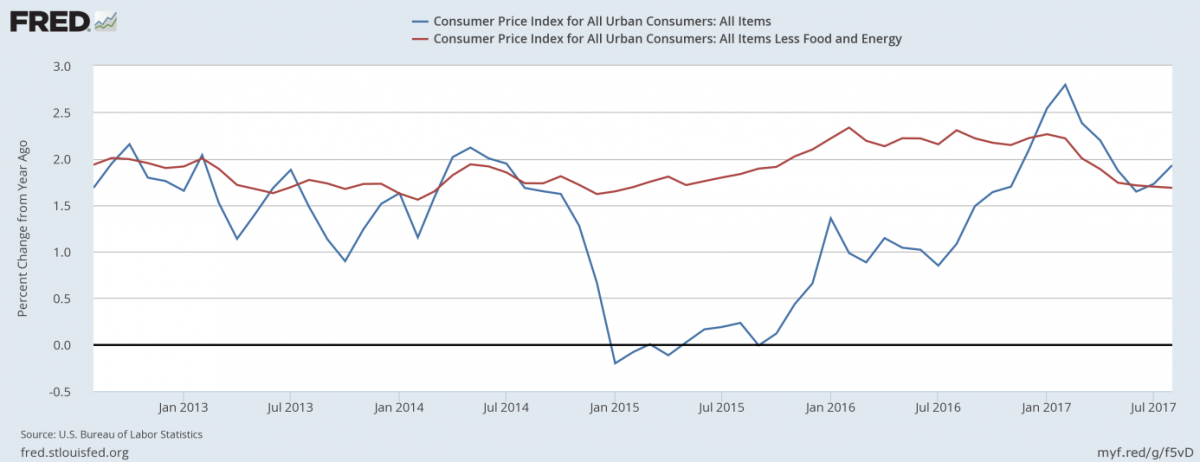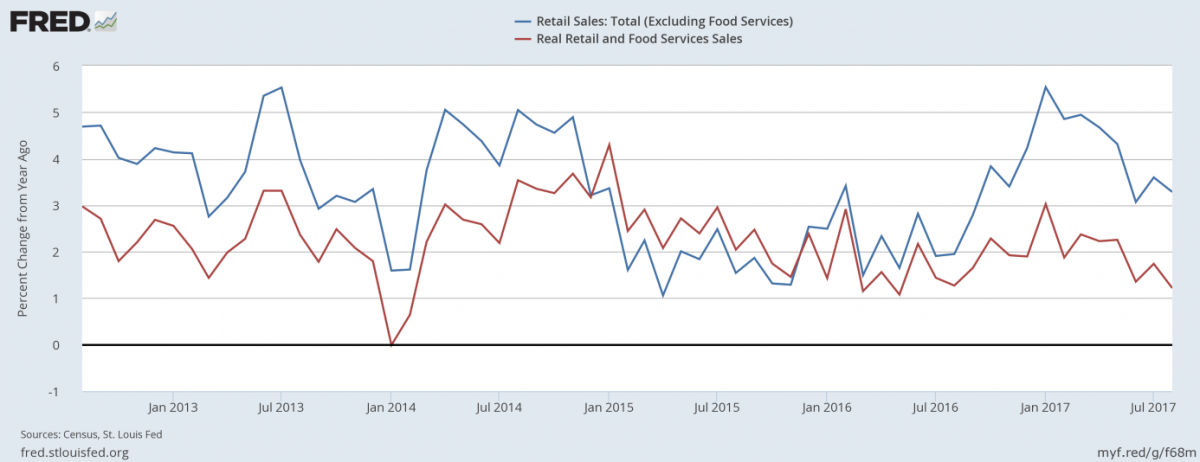August Inflation, Retail Sales And Gold Price

Last week, important pieces of US economic data were released, including the consumer price index and retail sales. What does it imply for the gold market?
CPI Positively Surprises
Consumer prices rose 0.4 percent last month, while core CPI increased 0.2 percent. The latter index was in line with expectations, while the former even surpassed them. Actually, the move has been the biggest upward change since January. On an annual basis, CPI jumped 1.9 percent, while the index which excludes food and energy rose 1.7 percent. And even U.S. wholesale prices increased 0.2 percent on a monthly basis and 2.4 percent for the past 12 months. Therefore, there was a rebound in inflationary dynamics, as one can see in the chart below.
Chart 1: CPI (blue line) and core CPI (red line) year-over-year from August 2012 to August 2017.
However, inflation is still muted, especially the core index. The truth is that a 2.8 percent jump in the costs of energy and a 6.3 percent surge in the cost of gas accounted for a significant part of the increase in consumer prices last month. Although hurricane Harvey had a very small effect on survey response rates, it could contribute to the rise in the price of fuel after all the refining disruptions in the Houston area.
Retail Sales Disappoint
U.S. retail sales fell 0.2 percent in August following a 0.3 percent rise in July (after a downward revision from 0.6 percent). The number was significantly below expectations, as economists expected a 0.1 percent increase. Actually, it marked the second drop in three months and the worst decline in six months. However, the drop was mainly caused by a 1.6 percent plunge in sales at auto dealers. When we exclude vehicles, retail sales rose 0.2 percent in August, but, again, thanks mainly to the higher gasoline prices. And the annual growth slowed down further, as one can see in the chart below.
Chart 2: Real retail sales and food services sales (red line) and retail sales excluding food services (blue line) year-over-year from August 2012 to August 2017.
Although the impact of hurricane Harvey on retail sales was limited in August, the cleanup after it (and Irma) may cause some volatility in the upcoming reports.
Industrial Production Drops After Harvey
However, hurricane Harvey had an important effect on industrial production in August. The U.S. central bank reported that the U.S. industrial output plunged 0.9 percent in the last month, mainly due to the storm which hit the Gulf Coast of Texas, home to much of the nation’s output of oil and natural gas industries. Economists expected a 0.1 percent rise. But the Fed estimated that Harvey had reduced the rate of change in total output by roughly 0.75 percentage points. However, other regions grew. The Empire State Index, which is a gauge of New York-area manufacturing, remained near a three-year high, decreasing only slightly from 25.2 in August to 24.4 in September.
Conclusions
To sum up, the recent U.S. economic data was mixed for the gold market. On the one hand, retail sales disappointed, while hurricane Harvey hit industrial production. Weak data on retail sales and industrial output should support gold prices. On the other hand, hurricane effects will be temporary and will be reversed in the fourth quarter. And consumer prices positively surprised investors, lifting the market odds of a Fed hike in December. They rose from almost 40 percent a month ago to almost 60 percent today. The revival in the expectations of a hawkish Fed helped the U.S. dollar to rise, which negatively affected the gold prices. Although inflation remained muted, the August report strengthened the hawkish camp at the FOMC which will argue for the beginning of balance-sheet unwinding at the meeting this week. A hawkish Fed should be negative for the gold market. Stay tuned!
Disclaimer: Please note that the aim of the above analysis is to discuss the likely long-term impact of the featured phenomenon on the price of gold and this analysis does not indicate (nor does it aim to do so) whether gold is likely to move higher or lower in the short- or medium term. In order to determine the latter, many additional factors need to be considered (i.e. sentiment, chart patterns, cycles, indicators, ratios, self-similar patterns and more) and we are taking them into account (and discussing the short- and medium-term outlook) in our trading alerts.
********




















